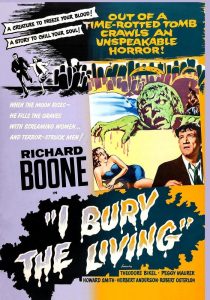I Bury the Living (1958) starring Richard Boone, Theodore Bikel, Peggy Maurer
I Bury the Living begins like an episode of The Twilight Zone: a successful businessman is pressured to “take his turn” as the head of the Immortal Hills Cemetary. On the map of the cemetery plots, white pins represent plots that have been purchased, and black pins represent where the dead are buried. But when he mistakenly puts a black pin in the wrong place, people begin to die …
The premise of I Bury the Living is actually interesting, and the acting is good as well — especially on the part of new cemetery manager Robert Kraft (Richard Boone), as the audience wonders if he’s slowly going mad with each passing death, or if he truly has some bizarre psychic ability to cause death. The caretaker, Andy McKee (Theodore Bikel) is fine, with an affected Scottish accent. Kraft’s suffering girlfriend (Peggy Maurer) is fine in her role, and the initially-not-interested reporter (Herbert Anderson, Dennis the Menace) is quite good.
If there’s a problem with I Bury the Living, it’s that the ending of the movie does a 90-degree turn, and turns an interesting story into a pedestrian murder mystery, and that’s a pity.
Cast of characters
- Richard Boone (Have Gun Will Travel) … Robert Kraft
- Theodore Bikel (My Fair Lady) … Andy McKee
- Peggy Maurer … Ann Craig
- Howard Smith … George Kraft
- Herbert Anderson (Dennis the Menace) … Jess Jessup
- Robert Osterloh … Lt. Clayborne
Editorial review of I Bury the Living courtesy of Amazon.com
Robert Craft has just become the new caretaker of the Immortal Hills Cemetery, assisted by Andy. On the office wall hangs a map covered by colored pins – the black where someone is buried, the white where a plot remains open. When Robert accidentally puts black instead of white pins on two plots recently sold to a pair of newlyweds, and the couple dies soon after, Robert becomes convinced that he’s responsible for their deaths. Or maybe the whole thing is just coincidence … until it happens again. Directed by Albert Band. Written by Louis Garfinkle. Cinematography by Frederick Gately. Produced by Albert Band and Louis Garfinkle.



